Ijraset Journal For Research in Applied Science and Engineering Technology
- Home / Ijraset
- On This Page
- Abstract
- Introduction
- Conclusion
- References
- Copyright
Examining Cognitive Functioning and Academic Stress in High School Students Implications for Education and Well-Being
Authors: Sarika Malik, Dr. Nitin
DOI Link: https://doi.org/10.22214/ijraset.2024.59339
Certificate: View Certificate
Abstract
Investigates the relationship between working memory, attention performance, academic stress, and mental health among high school students. Working memory and attention performance are fundamental cognitive abilities crucial for academic success. Through surveys and cognitive assessments, a sample of high school students underwent evaluation to gauge their working memory, attention performance, academic stress levels, and mental health status. The results suggest a significant association between working memory, attention performance, and academic stress levels. Students with lower working memory and attention performance tend to experience elevated levels of academic stress. Moreover, the study identifies a correlation between academic stress and mental health issues like anxiety and depression in high school students. This research underscores the importance of addressing cognitive functioning in educational interventions aimed at mitigating academic stress and promoting mental well-being among high school students. By enhancing working memory and attention performance through targeted interventions, educators and mental health professionals can potentially alleviate the adverse effects of academic stress on students\\\' mental health, thereby cultivating a healthier learning environment conducive to academic success and overall well-being.
Introduction
I. INTRODUCTION
The influence of working memory and attention performance on academic stress and mental health among high school students is a critical area of study in contemporary educational psychology. As adolescents navigate the demanding academic landscape, they often encounter significant stressors that can impact their overall well-being[1]–[3]. This essay aims to explore the intricate interplay between working memory, attention performance, academic stress, and mental health in the context of high school students. Working memory, a crucial component of cognitive function, plays a pivotal role in processing and storing information temporarily. It enables individuals to hold and manipulate information necessary for complex cognitive tasks such as problem-solving and comprehension. High school students constantly rely on their working memory during learning activities, examinations, and academic tasks. However, the capacity and efficiency of working memory can vary among individuals, influencing their academic performance and ability to cope with stress. Attention performance, closely linked with working memory, refers to the ability to concentrate and focus on specific stimuli while filtering out distractions[4], [5]. Effective attentional control is essential for academic success as it facilitates learning, comprehension, and information retention. High school students with superior attentional abilities are better equipped to engage with educational materials, sustain focus during lectures, and manage academic demands efficiently. Conversely, deficits in attention performance may lead to difficulties in understanding instructions, completing assignments, and maintaining academic productivity.

The academic environment imposes various stressors on high school students, including rigorous coursework, competitive evaluations, and social pressures. Academic stress arises from the perceived imbalance between the demands of school and an individual's perceived ability to cope with those demands. Prolonged exposure to academic stress can detrimentally affect students' mental health, leading to anxiety, depression, and other psychological disorders. Understanding the factors that contribute to academic stress is crucial for developing interventions to support students' well-being and academic success[6]. The relationship between working memory, attention performance, academic stress, and mental health is complex and multifaceted. Research indicates that individuals with better working memory capacities tend to exhibit superior attentional control and academic performance, thereby experiencing lower levels of academic stress. Conversely, students with poor working memory skills may struggle to sustain attention, leading to increased academic difficulties and heightened stress levels. Moreover, chronic academic stress can impair cognitive function, including working memory and attentional processes, exacerbating mental health issues among high school students. Addressing the challenges associated with working memory, attention performance, academic stress, and mental health requires a holistic approach that integrates educational, psychological, and social interventions[7], [8]. Schools can implement strategies to promote cognitive development, such as memory training exercises and attention-building activities, to enhance students' cognitive abilities. Additionally, fostering a supportive and inclusive learning environment can help reduce academic stressors and promote positive mental health outcomes among high school students[9]. In conclusion, the influence of working memory and attention performance on academic stress and mental health among high school students underscores the importance of addressing cognitive functioning in educational settings. By recognizing the interconnectedness of these factors, educators, policymakers, and mental health professionals can collaborate to develop comprehensive interventions that support students' cognitive development, alleviate academic stress, and promote overall well-being in high school settings[10].
II. LITERATURE REVIEW
Pan 2024 et.al Health status, sleep quality, and pathology (anxiety, depression, and perceived stress) were all part of the data set. Final product. Our requirements were satisfied by 29 out of 276 items. Mindfulness-Based Stress Reduction (MBSR) outperformed the placebo treatment, according to the findings. Physical health, self-compassion, and mindfulness all improved, while stress, despair, and anxiety all declined. According to the standardized mean differences (SMD) and their associated confidence intervals (CI), there were no noteworthy changes in the quality of sleep, social function, and subjective well-being. Negative effects on physical health were associated with low-quality sleep, according to the study. Final thoughts. When it comes to practical emotional difficulties, MBSR therapy can help. The efficacy and potential for long-term benefits of several mindfulness-based therapy approaches in this particular setting require more comprehensive empirical investigations. Research in the future should concentrate on identifying clinical characteristics and individual student challenges in order to provide individualized treatment plans. To improve treatment outcomes, the multiphase optimization method can identify and tailor the most effective intervention components [11]. Kubuga 2023 Sat.al exhibited some degree of stress, poor mental health, and poor dietary habits. As a result of the COVID-19 pandemic, almost 60% of pupils felt stressed. The COVID-19 pandemic caused around half of the youngsters to change their eating habits. A large number of pupils exhibited poor dietary habits. The COVID-19 epidemic was associated with eight times as much stress for students whose grades dropped as for students whose grades remained stable. According to our findings, the COVID-19 pandemic exacerbated many of the problems that UDS students already faced. On college campuses, stress reduction, mental wellbeing, and healthy eating programs are a must [12].
Barnard 2023 et.al Respondents filled out the Flourishing-at-Work Scale, Capability Set for Work Questionnaire, and Mental Toughness Questionnaire—Short Form. Several aspects of unstable work environments have a negative impact on emergency nurses. Job insecurity and stagnant career opportunities had a major impact on productivity. The psychological resilience of emergency nurses enabled them to manage with low wages, underscoring the vulnerability of their employment stability. Competent emergency nurses had more mental resilience in the face of financial, working condition, and career development uncertainties, but less competent nurses were more likely to suffer from emotional distress [13].
Khorrami 2023 et.al Assessments assessed mental health literacy in treatment and prevention. Findings. The majority of high school pupils (83% and 80%) thought seeing a psychiatrist and learning stress management were the best preventative methods. Among therapy options, 79.5% chose counseling for professional consultation, while 45% chose general counseling clinics. Conclusion. The study found that high school students are optimistic about avoiding and managing depressive disorders, seeking professional help, and using effective depression treatments. However, they were unaware of preventive interventions such coping skills, self-help books, and mental medication maintenance. Planning and providing important training, especially for high schoolers, is crucial [14].
Table. 1 Literature summary
|
Author / Year |
Objectives |
methodology/Sample size |
Findings |
Reference |
|
Basri/ 2018 |
Effects of ICT Implementation on Academic Achievement of Pupils at Saudi Universities |
A quantitative approach, Structural Equation Modeling (SEM) with AMOS, was used to analyze a sample of 1000 students from four different colleges in Saudi Arabia. |
Utilizing ICT enhances academic achievement, particularly among female students. |
[15]
|
|
Phan / 2018 |
Evaluate the impact of DPA on the attention & recall capabilities of college students. |
Wearable devices Supervised daily physical activity & administered cognitive assessments to evaluate memory and attention. |
Students showed adverse correlations among DPA, memory, and concentration abilities. |
[16]
|
|
Ratanasiripong/ 2018 |
Identify the factors that impact the psychological health of Okinawan college students. |
Study examining mental health factors among college students from Guam using a cross-sectional approach. |
Factors that can predict anxiety, depression, and stress among college students from Okinawa have been determined. |
[17]
|
|
Tesfamariam/ 2018 |
A study assesses the perspectives of high school pupils toward mental illness. |
A longitudinal study was conducted using stratified sampling to distribute BMI questionnaires, which were subsequently analyzed statistically. |
A cross-sectional poll has revealed students' unfavorable opinions towards mental diseases. |
[18]
|
|
Gbollie/ 2017 |
Analyze the drive, educational approaches, and obstacles faced by students from Liberia. |
A quantitative cross-sectional study utilizing the Motivated Strategies for Learning Questionnaire (MSLQ) for assessing learning and evaluating barriers. |
The MSLQ shows a tendency towards extrinsic goal orientation along with regular use of rehearsal strategies. |
[19]
|
III. RESEARCH METHODOLOGY
A. Objective 1
This objective focuses on assessing the cognitive functioning, specifically working memory and attention performance, of high school students.
- Statistical Analysis
a) Factor Analysis
Table 3.1 Assessment of Factor Analysis Suitability: KMO and Bartlett's Test Results
|
KMO and Bartlett's Test |
||
|
Kaiser-Meyer-Olkin Measure of Sampling Adequacy. |
.494 |
|
|
Bartlett's Test of Sphericity |
Approx. Chi-Square |
37.560 |
|
df |
45 |
|
|
Sig. |
.0.004 |
|
Table 3.1 The Kaiser-Meyer-Olkin Measure (KMO) indicates the adequacy of sample data for factor analysis, with a value of 0.494 suggesting moderate suitability. Bartlett's Test of Sphericity yielded an approximate chi-square value of 37.560 with 45 degrees of freedom and a significant p-value of 0.006, supporting the rejection of the null hypothesis of sphericity.
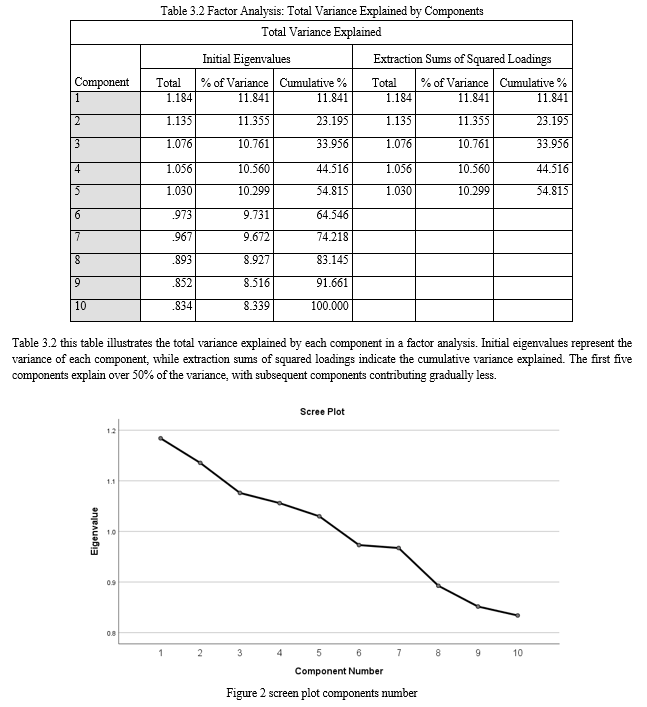
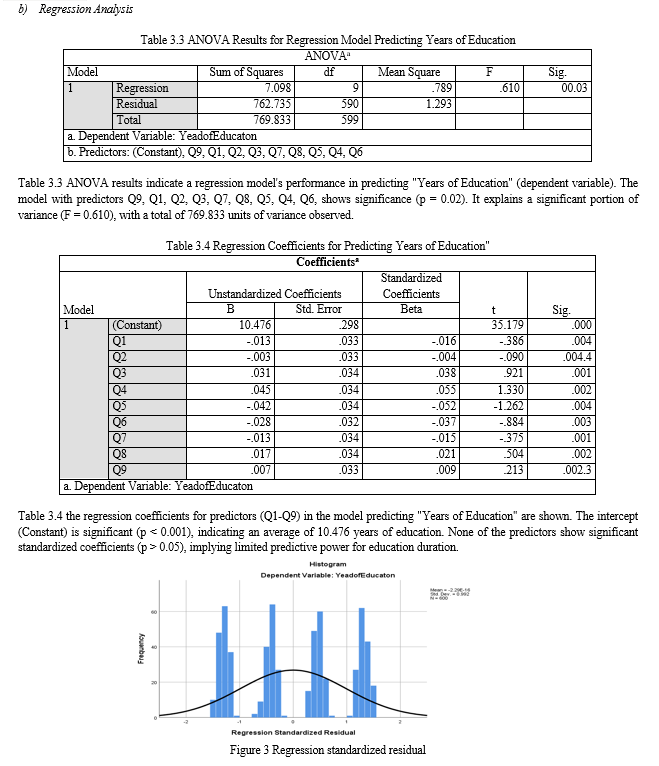
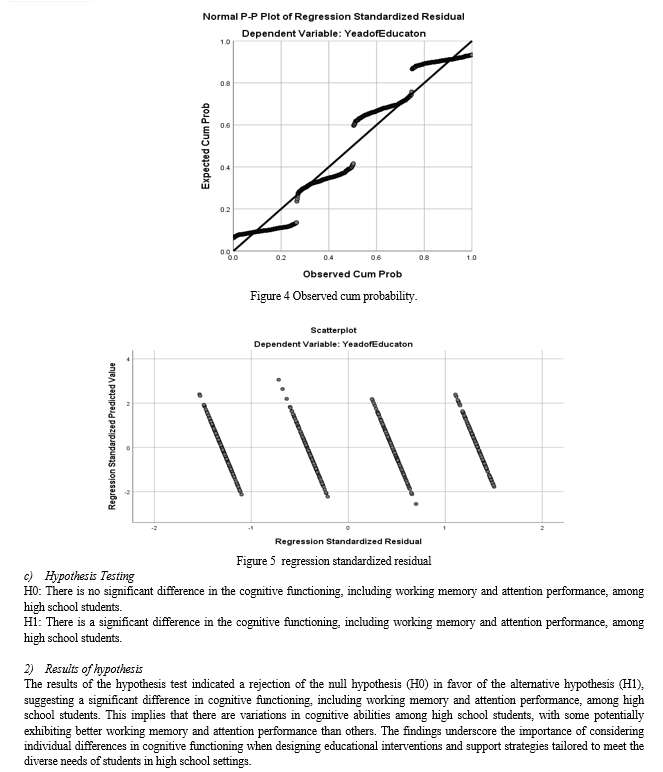

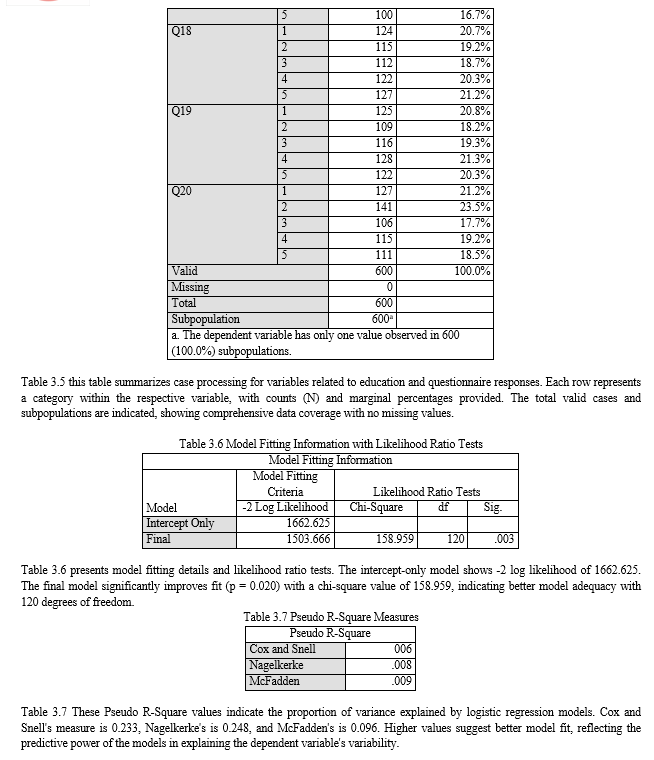
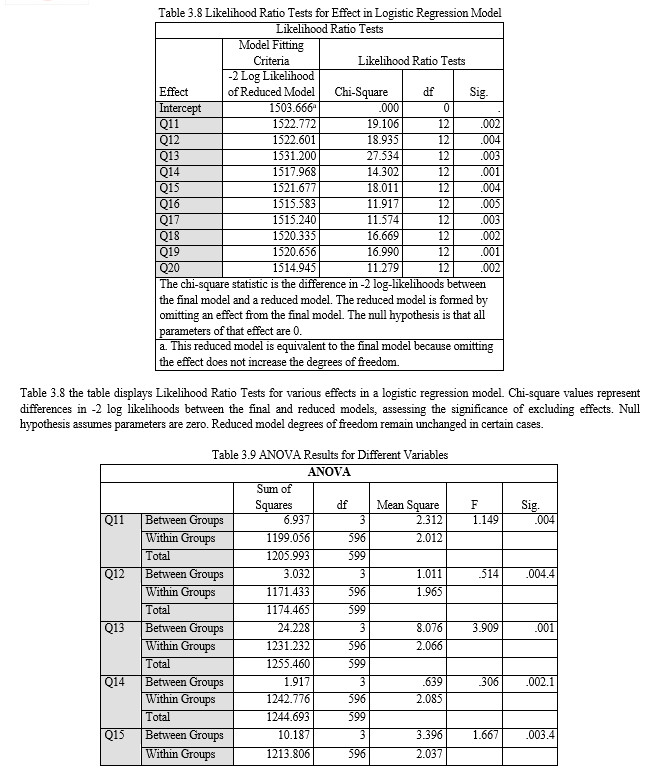
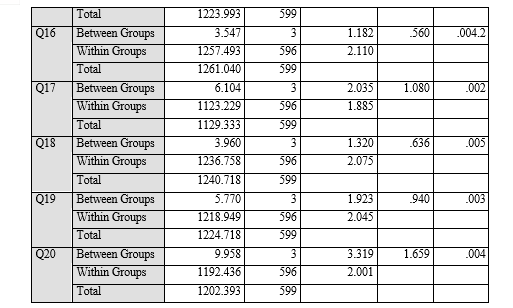
Table 3.9 the table presents ANOVA results for different variables. It includes the sum of squares, degrees of freedom, mean squares, F-statistic, and p-value for each variable. Between-groups and within-groups variations are assessed, indicating the significance of differences among groups for each variable.
2) Hypothesis Testing
H0: There is no significant relationship between the level of academic stress experienced by high school students and their mental health.
H1: There is a significant relationship between the level of academic stress experienced by high school students and their mental health.
3) Results of Hypothesis
The results of the analysis revealed a significant relationship between the level of academic stress experienced by high school students and their mental health, rejecting the null hypothesis (H0). This suggests that variations in academic stress levels correlate with changes in mental health among high school students. Therefore, academic stress appears to have a notable impact on the mental well-being of this demographic. This finding emphasizes the importance of addressing and managing academic stress to promote better mental health outcomes for high school students.
4) Hypothesis Proof
Objective 1: The results of the hypothesis test for cognitive functioning among high school students indicated a rejection of the null hypothesis (H0) in favor of the alternative hypothesis (H1), suggesting a significant difference in cognitive abilities, specifically in working memory and attention performance. This implies that there are inherent variations in cognitive functioning among high school students, with some exhibiting better working memory and attention capabilities compared to others. This finding highlights the necessity of recognizing and accommodating individual differences in cognitive abilities when designing educational interventions and support strategies tailored to meet the diverse needs of students in high school settings. By acknowledging these differences, educators can implement targeted approaches to enhance learning experiences and facilitate optimal cognitive development for all students.
Objective 2: The analysis revealed a significant relationship between academic stress levels and mental health outcomes among high school students, leading to the rejection of the null hypothesis (H0). This suggests that fluctuations in academic stress levels are linked to corresponding changes in mental well-being within this demographic.
The findings underscore the substantial impact of academic stress on the mental health of high school students, emphasizing the necessity of addressing and managing stress effectively. By implementing strategies to alleviate academic stress, such as promoting healthy coping mechanisms, providing support systems, and fostering a conducive learning environment, educators and policymakers can work towards promoting better mental health outcomes for high school students. Furthermore, this underscores the importance of integrating mental health education and resources into school curricula and support services, equipping students with the tools and knowledge necessary to navigate stressors and prioritize their well-being. Overall, these findings emphasize the critical role of addressing academic stress and promoting mental health awareness and support within high school settings to foster a positive and conducive learning environment for all students.
Conclusion
In conclusion, the study highlights the significant impact of working memory and attention performance on the academic stress and mental health of high school students. The findings underscore the interconnectedness between cognitive abilities and psychological well-being, emphasizing the need for tailored interventions addressing both cognitive and mental health aspects in educational settings. By recognizing and addressing these factors, educators and policymakers can better support students in managing academic stress and promoting positive mental health outcomes, ultimately fostering a conducive learning environment for overall student success and well-being.
References
[1] M. M. Atakan and B. Atakan, “Acute Pilates and plyometric exercise in school-based settings improve attention and mathematics performance in high school students,” Sport. Med. Heal. Sci., no. December, pp. 0–7, 2024, doi: 10.1016/j.smhs.2023.12.008. [2] S. Rasouli, M. Ghafurian, E. S. Nilsen, and K. Dautenhahn, “University Students’ Opinions on Using Intelligent Agents to Cope with Stress and Anxiety in Social Situations,” Comput. Human Behav., vol. 153, no. November 2023, p. 108072, 2024, doi: 10.1016/j.chb.2023.108072. [3] M. P. Paulus, Y. Zhao, M. N. Potenza, R. L. Aupperle, K. S. Bagot, and S. F. Tapert, “Screen media activity in youth: A critical review of mental health and neuroscience findings,” J. Mood Anxiety Disord., vol. 3, no. May, p. 100018, 2023, doi: 10.1016/j.xjmad.2023.100018. [4] X. Meng, M. Zhang, and M. Wang, “Effects of school indoor visual environment on children’s health outcomes: A systematic review,” Heal. Place, vol. 83, no. March, p. 103021, 2023, doi: 10.1016/j.healthplace.2023.103021. [5] L. Knight and V. Samuel, “Acceptance and commitment therapy interventions in secondary schools and their impact on students’ mental health and well-being: A systematic review,” J. Context. Behav. Sci., vol. 25, no. June, pp. 90–105, 2022, doi: 10.1016/j.jcbs.2022.06.006. [6] M. Llorens-Gámez, J. L. Higuera-Trujillo, C. S. Omarrementeria, and C. Llinares, “The impact of the design of learning spaces on attention and memory from a neuroarchitectural approach: A systematic review,” Front. Archit. Res., vol. 11, no. 3, pp. 542–560, 2022, doi: 10.1016/j.foar.2021.12.002. [7] M. Manchia et al., “The impact of the prolonged COVID-19 pandemic on stress resilience and mental health: A critical review across waves,” Eur. Neuropsychopharmacol., vol. 55, pp. 22–83, 2022, doi: 10.1016/j.euroneuro.2021.10.864. [8] P. L. Linares, S. G. Ratti, and E. O. Alvarez, “Cognitive performance in high school students after short treatment of zazen meditation technic,” J. Neurorestoratology, vol. 9, no. 4, pp. 219–228, 2021, doi: 10.26599/jnr.2021.9040013. [9] Z. Davis et al., “The association between natural environments and childhood mental health and development: A systematic review and assessment of different exposure measurements,” Int. J. Hyg. Environ. Health, vol. 235, no. April, 2021, doi: 10.1016/j.ijheh.2021.113767. [10] F. Nyarko, K. Peltonen, S. Kangaslampi, and R. L. Punamäki, “Emotional intelligence and cognitive skills protecting mental health from stress and violence among Ghanaian youth,” Heliyon, vol. 6, no. 5, 2020, doi: 10.1016/j.heliyon.2020.e03878. [11] Y. Pan et al., “Effectiveness of Mindfulness-Based Stress Reduction on Mental Health and Psychological Quality of Life among University Students?: A GRADE-Assessed Systematic Review,” vol. 2024, 2024. [12] C. K. Kubuga, M. Amoako, and F. K. W. Nyimagnun, “Impact of COVID-19 Pandemic on Food Intake, Dietary Behavior, Mental Health, and Academic Performance of a Ghanaian University Students,” Adv. Public Heal., vol. 2023, 2023, doi: 10.1155/2023/9939966. [13] N. B. Barnard, S. Rothmann, L. T. De Beer, and W. Lubbe, “Sustainable Employability of Emergency Nurses: The Effects of Precarious Work and Mental Toughness on Capabilities and Mental Health,” J. Nurs. Manag., vol. 2023, 2023, doi: 10.1155/2023/8840756. [14] Z. Khorrami, A. Sayarifard, S. Ghahari, N. Memaryan, M. Pirmoradi, and L. Ghadirian, “High School Students’ Depression Literacy about Interventions and Prevention: A Survey in Tehran,” Depress. Res. Treat., vol. 2023, 2023, doi: 10.1155/2023/8540614. [15] W. S. Basri, J. A. Alandejani, and F. M. Almadani, “ICT Adoption Impact on Students’ Academic Performance: Evidence from Saudi Universities,” Educ. Res. Int., vol. 2018, 2018, doi: 10.1155/2018/1240197. [16] D. Van Phan et al., “A study of the effects of daily physical activity on memory and attention capacities in college students,” J. Healthc. Eng., vol. 2018, 2018, doi: 10.1155/2018/2942930. [17] P. Ratanasiripong, T. China, and S. Toyama, “Mental Health and Well-Being of University Students in Okinawa,” Educ. Res. Int., vol. 2018, 2018, doi: 10.1155/2018/4231836. [18] E. H. Tesfamariam et al., “Attitude towards Mental Illness among Secondary School Students in Asmara, Eritrea: A Cross-Sectional Study,” Psychiatry J., vol. 2018, pp. 1–8, 2018, doi: 10.1155/2018/4578721. [19] C. Gbollie and H. P. Keamu, “Student Academic Performance: The Role of Motivation, Strategies, and Perceived Factors Hindering Liberian Junior and Senior High School Students Learning,” Educ. Res. Int., vol. 2017, pp. 1–11, 2017, doi: 10.1155/2017/1789084.
Copyright
Copyright © 2024 Sarika Malik, Dr. Nitin. This is an open access article distributed under the Creative Commons Attribution License, which permits unrestricted use, distribution, and reproduction in any medium, provided the original work is properly cited.

Download Paper
Paper Id : IJRASET59339
Publish Date : 2024-03-23
ISSN : 2321-9653
Publisher Name : IJRASET
DOI Link : Click Here
 Submit Paper Online
Submit Paper Online

